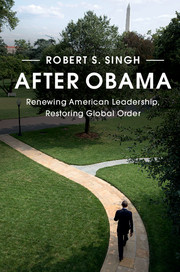Book contents
5 - The way forward: a new American internationalism
Published online by Cambridge University Press: 05 May 2016
Summary
America is at a strategic crossroads. The post-Obama years offer a simple but profound choice: continue a set of well-intentioned but failed and failing policies that have weakened the United States, the free world and international order, or change course. A strong case commends embracing a new direction based on the confluence of interests and ideals that informed America's rise to global preeminence. And if there exists some irony in recalling the past to guide future direction into the third decade of the twenty-first century, that is only appropriate. Reverence for the wisdom of the framers of the US Constitution – flawed as they were – and the values underpinning constitutional democracy still strongly informs domestic political debates. A return to an effectively enlightened foreign policy tradition – flawed in execution as it sometimes was – seems equally judicious at this critical juncture.
In the looming choice over the future of US statecraft, there are echoes of 1980, when Americans had the opportunity to confirm a failed strategy by reelecting Jimmy Carter as president or embark on a more assertive path under Ronald Reagan. But, if anything, the contemporary challenge is even more momentous. In 1980, the bipolar structure of international relations seemed entrenched; even Reagan was not bold enough to predict the beginning of the Cold War's final days on his watch. By contrast, global politics are now more unstable than at any time since the 1930s. The stakes are as high as the outcomes are uncertain. The terminal prospect of world order collapsing and an unstable multipolarity, or even a chaotic a-polarity, emerging is very real. The next president will craft relations with a world in flux until 2021 or 2025, a period that could prove as consequential for US power and prosperity as any since 1945. Much more than merely ratifying retrenchment and retreat, or recrafting the policies that made America a global power without precedent, hangs in the balance.
Like Carter in his final year, Obama too quietly acknowledged the error of his ways by latterly modifying his approach in 2015–16, breaking his own “redlines” (keeping 9,880 troops through 2016 in Afghanistan and 5,500 into 2017, sending troops to Iraq and special operations forces into Syria).
- Type
- Chapter
- Information
- After ObamaRenewing American Leadership, Restoring Global Order, pp. 98 - 130Publisher: Cambridge University PressPrint publication year: 2016



